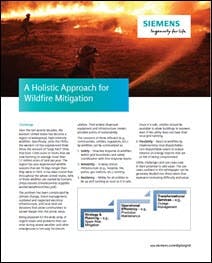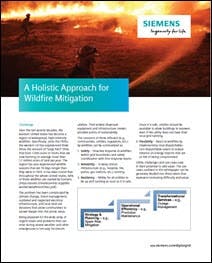It seems over the past few years, during peak season when rain is short, all the west coast — and across the country for that matter — hears about is wildfires. They continue to worsen, and over the last several decades, the western United States has become a region of widespread, high-intensity wildfires. That’s according to a new report from Siemens that offers a “holistic approach to wildfire mitigation.”
Download the full report.
Why have wildfires been so prevalent as of late? According to the report, the issue has been amplified by climate change, forest management, outdated and neglected electrical infrastructure, and local land-use decisions that allow communities to sprawl deeper into wildfire-prone areas.
These new use cases call for new technology. But normal ongoing reliable operations need to go on as usual, as well.
In fact, “leveraging existing systems and assets while implementing advanced solutions rapidly is a complex balancing act,” says the report.
The focus of what Siemens calls a “holistic: approach for wildfire mitigation is to “be a complementary overlay to the entity’s distributed generation architecture to enable better outcomes.”
The report explores risk mitigation planning in detail. The problem? Many organizations might not currently have stated mitigation goals, because they simply do not know where to start.
A thorough investigation will take a look at existing equipment condition, connected infrastructure, region, weather data, network operation data, and protection coordination settings in response to variable conditions/scenarios and more. The report explores the following elements in detail as pieces of the solution that risk mitigation planning could uncover:
- Environmentally-aware distribution automation
- Intelligent microgrid controllers
- Data processing
- Contextual awareness
- Situational awareness
- Predictive analytics
- Prescriptive analytics
- Automated actions
The report also highlights a case study featuring Blue Lake Rancheria, a Native American reservation in Northern California equipped with a low-carbon community microgrid to help power government offices, economic enterprises, and critical Red Cross safety shelter-in place facilities across 100 acres. The facility uses the Siemens Microgrid Management System.
According to Siemens, the Rancheria achieved 100% resiliency during the recent Shasta and Trinity Counties ‘Carr Fire’ in the summer of 2018 by using its microgrid management system.
Ultimately, this new report from Siemens outlines how with robust microgrid and emergency power supplies, critical infrastructure can potentially continue to serve thousands of people with life, health, and safety services.
Download the new report, “A Holistic Approach for Wildfire Mitigation,” courtesy of Siemens, that highlights the challenges and solutions to mitigating wildfires today and the technology that makes the difference.








